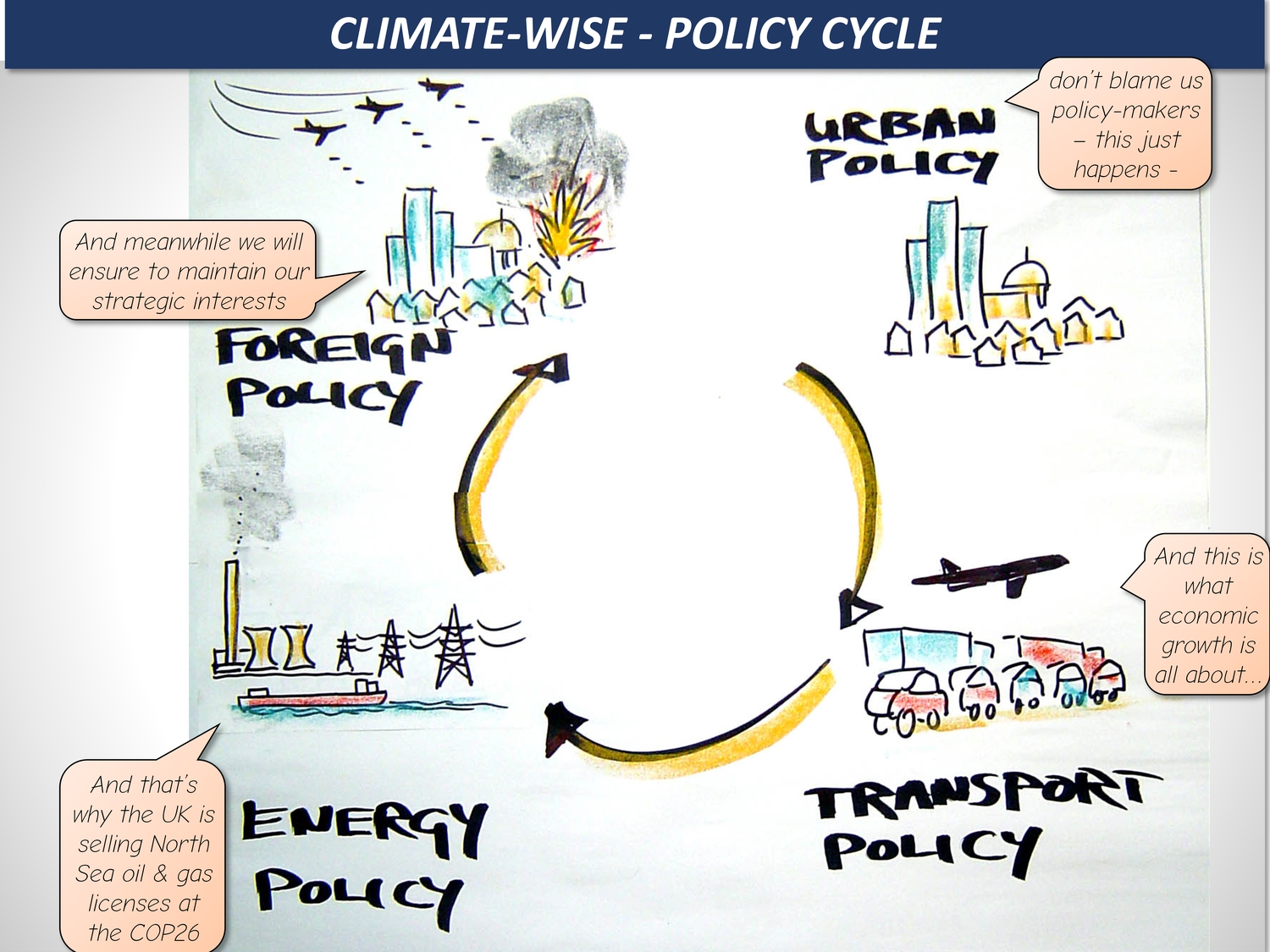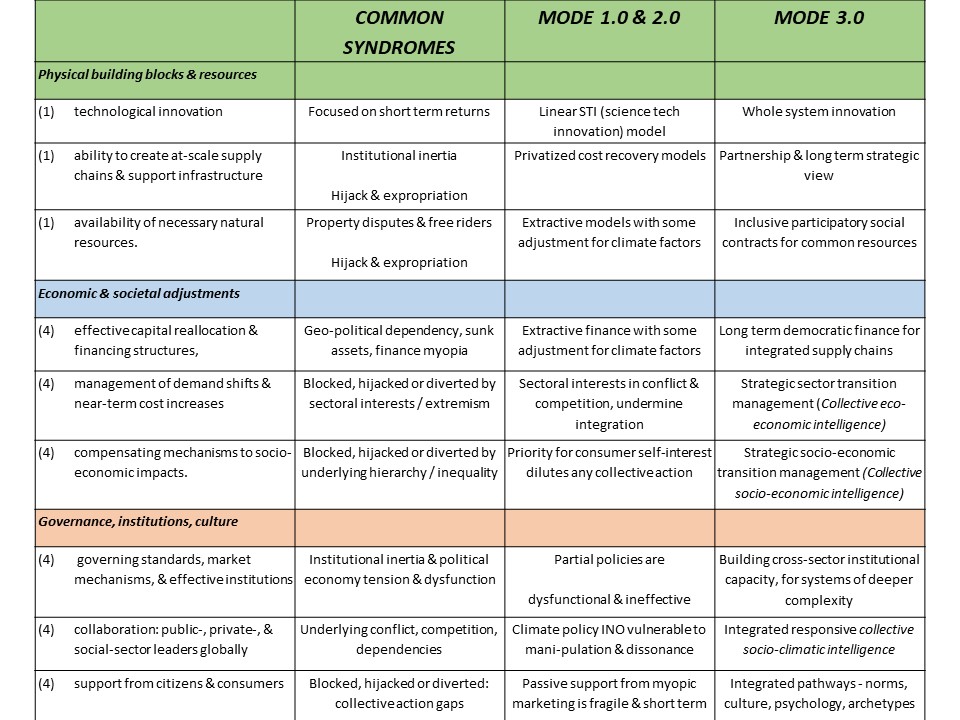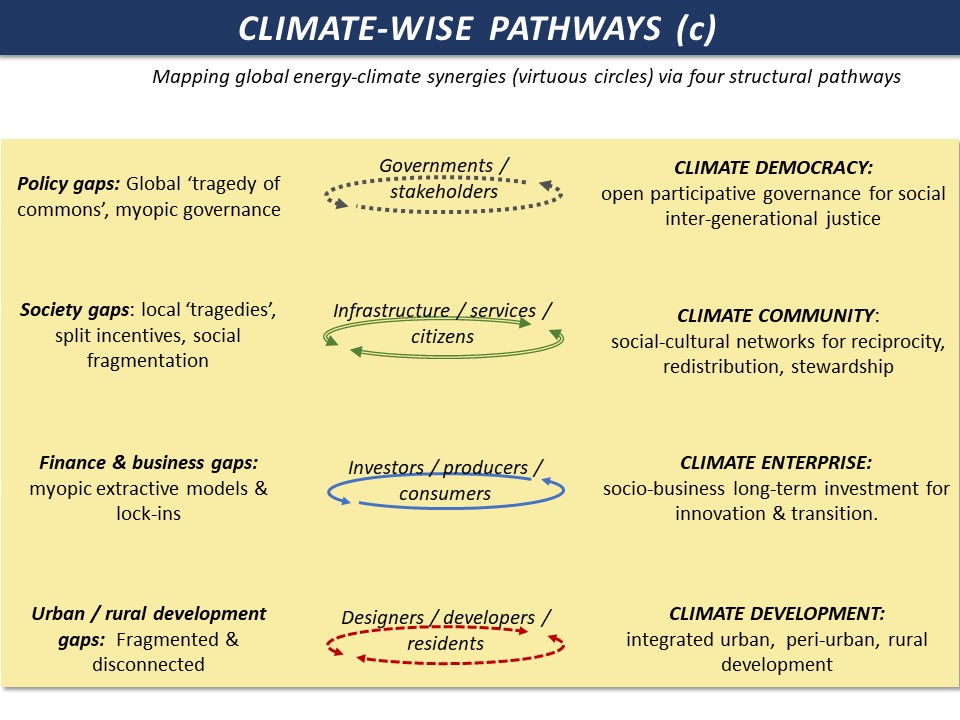Climate-wise – mapping the frontiers
With 25000 climate-focused people from around the world, the meeting is inspirational – but – also in some kind of bubble. Many of the climate adaptation plans, mitigation roadmaps etc, don’t seem to connect with the ‘big bad real world’ – the labyrinth of power games, extractive finance, elite capture and corruption, psycho-social denial, and dysfunctionality of all kinds. And since November…
- Russia masses its armies around Ukraine – Europe’s gas supply is the bargaining chip
- USA is on the brink (some argue) of asymmetric civil war – climate denial is a fault-line
- UK is in a constitutional meltdown – while its energy retrofit program is hastily taken down
- Xi Jinping confirms Chinese climate action takes second place to economic development
In the UNFCCC negotiating rooms the way through the labyrinth is framed as ‘net-zero’. This assumes that CO2 emissions can be offset in forests, or stored underground with as yet untested technology. Is this a convenient greenwash, or a genuine solution to a global challenge?? Does it assume that forests and tribal lands are commodities for the global carbon markets?? Certainly there will be financiers and consultants preparing for a killing…
In the 100s of other parallel sessions and side events, there are noticeable gaps between the rhetoric of adaptation – inclusive, transformative, grassroots focused etc – and the reality of land, resources and power. The $100billion finance promise is still to materialize, and this is a major sticking point in the south-north dialogue. But from experience, wherever money arrives there will be well equipped and ruthless landowners, consultants, politicians and entrepreneurs, to divert and build their portfolios.
Another fault-line – elite capture of the climate agenda – easily polarized and inflamed, when presidents and royal families arrive on private jets, stay in 5* hotels and lecture the world on consuming less…
So – the pages below are a start to open up this space of challenges and contradictions. It seems climate policy would be great, if it worked – but often it doesn’t – so we need to understand and bring to the surface the ‘big bad world’ effects. Some of this is very generalized, looking across the whole of climate policy. Some topical examples bring this to life: carbon offsetting, building retrofit, low carbon transport etc.
We use visual systems mapping as the primary tool – if we are ‘rewiring’ the global socio-climatic system, we need a wiring diagram – a mapping of the ‘socio-climatic mindscape’. With this we have a much better chance of designing systematically for climate action pathways which can succeed against all the challenges.
For more see the Climate-wise toolkit – briefing paper 1 – Jan 2021

CLIMATE WISE – MINDSCAPE
This mapping starts with a ‘mindscape’ of possible socio-climatic combinations (with suggested titles).
At this stage, the mapping is very generalized: each sector or problem will have specific priorities on this general mapping (see carbon offset example overleaf). First we set up 2 axes – (these could be taken as scenarios, or as general mindsets, or clusters of syndromes):
- Success in climate policy & action – versus – Failure in climate policy with gaps & barriers
- Positive socio-political progress – versus – Negative socio-political gaps & barriers
This then produces 1+4 possible combinations or corners (the first being in the centre)
- Climate single issue: isolated technical actions lack connection to socio-political agendas
- Climate hijack: complicit & dependent on elite power, extraction, exclusion, extremism
- Climate blockage: undermined by socio-political conflict, extraction, corruption & general inertia
- Climate diversion: agenda replaced by socio-political agenda, prosperity, community etc
- Climate wise: as catalyst for socio-political change & transformation in all domains

Example – Carbon Offsetting
Carbon offsetting is one of the key components of the global net-zero program. It is also notorious for double-thinking, hijack and diversion – land grabs, dubious accounting, financial speculation bubbles, false promises and scam marketing to green consumers (e.g. https://reliefweb.int/report/world/tightening-net-net-zero-climate-targets-implications-land-and-food-equity) . “many governments and corporations are hiding behind unreliable, unproven and unrealistic ’carbon removal’ schemes in order to claim their 2050 climate change plans will be ‘net zero’. Their sudden rush of ‘net zero’ promises are relying too much on vast swathes of land to plant trees in order to remove greenhouse gases from the atmosphere. At the same time, they are failing to cut emissions quickly or deeply enough to avert catastrophic climate breakdown.”
Again the questions are quite direct – how would you (as a subsistence farming village, rural landowner, green financier / automobile executive / housing developer, lower-income citizen etc) make the most of this new opportunity??
This mindscape summarizes the possible corners, and leaves for exploration what happens next.
- 1) Climate single issue: offsets are a technical extension of global carbon management
- 2) Climate Hijack: Offsets are new ‘resource curse’ with land grabs & speculation by elite power & global finance
- 3) Climate Blockage: Offsets are (a) simply blocked, or (b) technically flawed, with negative effects for both climate & socio-political change
- 4) Climate Diversion: Offsets fail as they can’t respond to socio-political agenda of livelihood, community etc
- 5) Climate-wise: offsets are managed as local / indigenous resources linked to sustainable livelihoods & land management

1) ‘Climate-Single Issue’ – mapping the challenges
Next we can explore further in each corner with multiple domains, worldviews or value systems: social, technical, economic, political, cultural, territorial etc (‘STEEPC’). Note these domains are not fixed in stone – there are many alternative versions: there are also schemes such as CLA which explore surface / underlying factors: or CAM which focuses on the ‘affective’ feelings of participants. Here we just take a simple flexible approach as a starting point to be followed up as needed.
The next 5 pages set out some domain mappings, for each of the corners of the basic mindscape above.
The first Climate single-issue’ is a general mapping of basic challenges, contradictions, resistances, gaps, barriers, fractures & fault-lines between conflicting domains of logic & value. Each item here is a potential challenge to the straight line approach of ‘climate single issue’.

2) ‘Climate Hijack’ Strategy Mapping
Climate hijack: complicit & dependent on elite power, extraction, exclusion, extremism
Mindscape mapping of 6 inter-connecting domains, where climate action is easily hi-jacked / expropriated by other agendas of power wealth & ideology:
- Question – how to make money / power from climate action??

3) ‘Climate Blockage’ Strategy Mapping
Climate blockage: undermined by socio-political conflict, extraction, corruption & general inertia
Mindscape mapping of 6 inter-connecting domains, where both climate action & social action are blocked by more powerful forces. (titles are shown as ‘6-D’)
- Question – how to make money / power by undermining / blocking climate action with social action??

4) ‘Climate Diversion’ Strategy Mapping
Climate diversion: agenda replaced by socio-political agenda, prosperity, community etc
Mindscape mapping of 6 inter-connecting domains, where climate action is traded / sacrificed / displaced in favour of social action. (titles are shown as ‘6-D’)
- Question – how to make money / power by trading climate action for social action ??

5) ‘Climate-Wise’ Strategy Mapping
Climate wise: as catalyst for socio-political change & transformation in all domains
Mindscape mapping of climate action success: as win-win virtuous cycles in each domain, also with synergies on the inter-connections:
- Question – how to make benefits all around via collaboration with competitors on combined climate & social action
This then provides the backdrop to the exploration of pathways in the following pages. For this we use more tools such as:
- actor mapping (stakeholders and their interactions): and
- factor mapping (value chains / metabolism / causes-effects)
Firstly we see an example (overleaf) from urban low-carbon transport policy

Example ‘Climate Hijack’: urban transport
Urban transport is a classic case, with many trade-offs / contradictions between social economic and climatic agendas. (e.g. low traffic neighbourhoods can lead to gentrification: subsidy for rail travel goes to higher income groups: EVs are exclusive of lower incomes, etc..)
This mindscape focuses on a crucial combination of domains: climatic/ social / political. This helps to explore the common fractures and contradictions in the case of urban transport.
- Question – how to make money & power by exploiting climate policy on urban transport
Some of these syndromes can lead to climate hijack, some to total blockage and some to diversion.

4) CLIMATE ACTION CO-EVOLUTIONARY ANALYSIS
There are many analyses and frameworks for the socio-climatic challenge. We take one here from the McKinsey Global ‘System Conditions’, a very perceptive overview published for the COP21. This follows from and links with the six domains shown above (McKinsey & Co, 2021, Solving the net-zero equation: Nine requirements for a more orderly transition. Boston, MGI).
“Net-zero commitments are rising, but the net-zero equation is not yet solved. This can only change if nine interdependent requirements are met with singular resolve, unity, and ingenuity:
- Physical building blocks, encompassing (1) technological innovation, (2) ability to create at-scale supply chains and support infrastructure, and (3) availability of necessary natural resources.
- Economic and societal adjustments, comprising (4) effective capital reallocation and financing structures, (5) management of demand shifts and near-term unit cost increases, and (6) compensating mechanisms to address socioeconomic impacts.
- Governance, institutions, and commitment, consisting of (7) governing standards, tracking and market mechanisms, and effective institutions, (8) commitment by, and collaboration among, public-, private-, and social-sector leaders globally; and (9) support from citizens and consumers.
Following this via the synergistic Climate-wise approach we can explore how each of these ‘system conditions’ generates
- Common syndromes (as above, ‘climate hijack, climate blockage, climate diversion’, or some combination of such):
- Mode 1.0 responses (linear, functional approaches) – with Mode 2.0 responses (evolutionary, myopic, innovative competitive),
- Mode 3.0 responses (co-evolutionary, integrated, collaborative-inclusive)

SOCIO-CLIMATIC PATHWAY MAPPING
This section is a shorter version of the Climate-III section of Deeper-City: Collective-Intelligence-and-the-Pathways-from-Smart-to-Wise – More details are there if needed, or on the download Deeper City – 6-3 – Climatic-III
Climate-wise factor mapping
We see the basic energy metabolism, as a ‘factor mapping’ on the left here, as a chain from primary resources, to secondary electricity, to distribution and storage, and then to energy demand and energy ‘services’. The impacts then track around the cycle, with a cause-effect impact chain, following the logic of the ‘DPSIR’ scheme (‘drivers-pressure-state-impacts-responses’). Here are the ‘driving forces’ of population/economic growth, ‘pressures’ from emissions, ‘state’ of the climate, direct ‘impacts’ of floods or droughts, and the downstream results or ‘responses’ for ecosystems policies, which then might feed back to the energy resources at the start.

Climate wise actor mapping
The ‘actor mapping’ here shows on the left, typical syndromes and gaps, in the interactions of profit and power in the energy-climate system. The format shows them as if around a table, while in practice a single table at one place and time may not be achieved. (Again these mappings are shown at the most general level possible – many more detailed mappings can be done for sectors, places, communities, technologies and so on).
Generally we see a corporate business model which buys governments, drives financial speculation, grabs indigenous land, locks into fossil fuels, and funds climate scepticism and denial. Behind this is a culture and psychology of extractive industry, material consumption, myopic pollution and a ‘tragedy of the commons’.
On the right we explore the possibility of synergistic pathways, in the sense they depend on synergies between multiple sets of actors / stakeholders. Different colours / lines represent different pathways (as discussed in the next section):

Climate-wise pathway mapping
These are the high level generalized pathways – each to be interpreted for specific examples. Each is the result of potential synergies between different sets of actors and factors –
- CLIMATE DEMOCRACY: open participative governance for social inter-generational justice
- CLIMATE COMMUNITY: social-cultural networks for reciprocity, redistribution, stewardship
- CLIMATE ENTERPRISE: socio-business long-term investment for innovation & transition.
- CLIMATE DEVELOPMENT: integrated urban, peri-urban, rural development
Climate democracy pathways
With a logic of social-political synergies, these pathways focus upstream of the energy supply chain, and downstream of the climate impact chain. Where indigenous people are displaced by energy or mineral extraction, or where farmers lose their livelihood by flood or drought, there’s an over-arching case for energy and/or climate justice, and the democratic system to underpin it. In human rights terms, every community should have a stake (economic, political, social), in ‘their’ resources, energy, land and livelihoods. But this raises huge questions: who is the community? Who speaks for them? And who decides what is ‘theirs’ in a world of conflicting claims, of migration and displacement and international trade? There are great examples of indigenous peoples facing big corporations alongside eco-activists (a very high risk profession), but there are other more tricky questions, such as indigenous communities in nature reserves, or local opposition to windfarms, or the human right to drive a car or fence private property.
for the other pathways see the download – Deeper City – 6-3 – Climatic-III

